See also
Types of nuclear fission reactor | |||||||||||||||
|---|---|---|---|---|---|---|---|---|---|---|---|---|---|---|---|
| Light water | |||||||||||||||
| Heavy water by coolant |
| ||||||||||||||
| |||||||||||||||
None (fast-neutron) |
| ||||||||||||||
| Others | |||||||||||||||
This article includes a list of lists.
This following is a list of articles listing nuclear reactors.
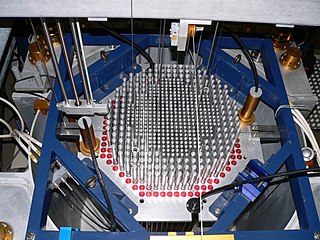
A nuclear reactor is a device used to initiate and control a fission nuclear chain reaction or nuclear fusion reactions. Nuclear reactors are used at nuclear power plants for electricity generation and in nuclear marine propulsion. Heat from nuclear fission is passed to a working fluid, which in turn runs through steam turbines. These either drive a ship's propellers or turn electrical generators' shafts. Nuclear generated steam in principle can be used for industrial process heat or for district heating. Some reactors are used to produce isotopes for medical and industrial use, or for production of weapons-grade plutonium. As of 2022, the International Atomic Energy Agency reports there are 422 nuclear power reactors and 223 nuclear research reactors in operation around the world.
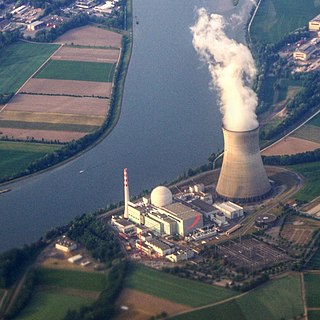
Nuclear power is the use of nuclear reactions to produce electricity. Nuclear power can be obtained from nuclear fission, nuclear decay and nuclear fusion reactions. Presently, the vast majority of electricity from nuclear power is produced by nuclear fission of uranium and plutonium in nuclear power plants. Nuclear decay processes are used in niche applications such as radioisotope thermoelectric generators in some space probes such as Voyager 2. Generating electricity from fusion power remains the focus of international research.

The Seawolf class is a class of nuclear-powered, fast attack submarines (SSN) in service with the United States Navy. The class was the intended successor to the Los Angeles class, and design work began in 1983. A fleet of 29 submarines was to be built over a ten-year period, but that was reduced to 12 submarines. The end of the Cold War and budget constraints led to the cancellation of any further additions to the fleet in 1995, leaving the Seawolf class limited to just three boats. This, in turn, led to the design of the smaller Virginia class. The Seawolf class cost about $3 billion per unit, making it the most expensive United States Navy fast attack submarine and second most expensive submarine ever, after the French Triomphant-class nuclear-powered ballistic missile submarines.
The Ship-Submarine Recycling Program (SRP) is the process that the United States Navy uses to dispose of decommissioned nuclear vessels. SRP takes place only at the Puget Sound Naval Shipyard (PSNS) in Bremerton, Washington, but the preparations can begin elsewhere.
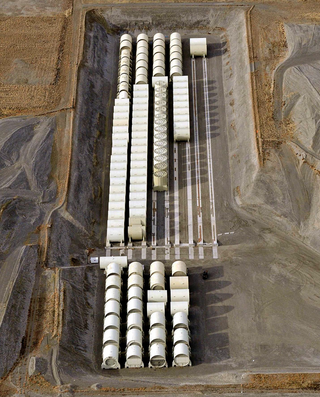
United States naval reactors are nuclear reactors used by the United States Navy aboard certain ships to generate the steam used to produce power for propulsion, electric power, catapulting airplanes in aircraft carriers, and a few more minor uses. Such naval nuclear reactors have a complete power plant associated with them. All U.S. Navy submarines and supercarriers built since 1975 are nuclear-powered by such reactors. There are no commissioned conventional (non-nuclear) submarines or aircraft carriers left in the U.S. Navy, since the last conventional carrier, USS Kitty Hawk, was decommissioned in May 2009. The U.S. Navy had nine nuclear-powered cruisers with such reactors also, but they have since been decommissioned. Reactors are designed by a variety of contractors, then developed and tested at one of several government owned and prime contractor-operated facilities: Bettis Atomic Power Laboratory in West Mifflin, Pennsylvania and its associated Naval Reactors Facility in Idaho, and Knolls Atomic Power Laboratory in Niskayuna, New York and its associated Kesselring site in West Milton, New York, all under the management of the office of Naval Reactors. Sometimes there were full-scale nuclear-powered prototype plants built at the Naval Reactors Facility, Kesselring, and Windsor to test the nuclear plants, which were operated for years to train nuclear-qualified sailors.

A fusor is a device that uses an electric field to heat ions to nuclear fusion conditions. The machine induces a voltage between two metal cages, inside a vacuum. Positive ions fall down this voltage drop, building up speed. If they collide in the center, they can fuse. This is one kind of an inertial electrostatic confinement device – a branch of fusion research.
Nuclear technology is technology that involves the nuclear reactions of atomic nuclei. Among the notable nuclear technologies are nuclear reactors, nuclear medicine and nuclear weapons. It is also used, among other things, in smoke detectors and gun sights.

A pressurized water reactor (PWR) is a type of light-water nuclear reactor. PWRs constitute the large majority of the world's nuclear power plants. In a PWR, the primary coolant (water) is pumped under high pressure to the reactor core where it is heated by the energy released by the fission of atoms. The heated, high pressure water then flows to a steam generator, where it transfers its thermal energy to lower pressure water of a secondary system where steam is generated. The steam then drives turbines, which spin an electric generator. In contrast to a boiling water reactor (BWR), pressure in the primary coolant loop prevents the water from boiling within the reactor. All light-water reactors use ordinary water as both coolant and neutron moderator. Most use anywhere from two to four vertically mounted steam generators; VVER reactors use horizontal steam generators.

ITER is an international nuclear fusion research and engineering megaproject aimed at creating energy by replicating, on Earth, the fusion processes of the Sun. Upon completion of construction of the main reactor and first plasma, planned for late 2025, it will be the world's largest magnetic confinement plasma physics experiment and the largest experimental tokamak nuclear fusion reactor. It is being built next to the Cadarache facility in southern France. ITER will be the largest of more than 100 fusion reactors built since the 1950s, with ten times the plasma volume of any other tokamak operating today.
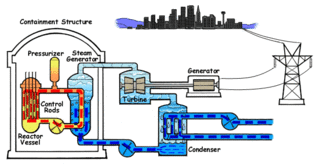
Nuclear propulsion includes a wide variety of propulsion methods that use some form of nuclear reaction as their primary power source. The idea of using nuclear material for propulsion dates back to the beginning of the 20th century. In 1903 it was hypothesized that radioactive material, radium, might be a suitable fuel for engines to propel cars, planes, and boats. H. G. Wells picked up this idea in his 1914 fiction work The World Set Free.

A nuclear submarine is a submarine powered by a nuclear reactor, but not necessarily nuclear-armed. Nuclear submarines have considerable performance advantages over "conventional" submarines. Nuclear propulsion, being completely independent of air, frees the submarine from the need to surface frequently, as is necessary for conventional submarines. The large amount of power generated by a nuclear reactor allows nuclear submarines to operate at high speed for long periods, and the long interval between refuelings grants a range virtually unlimited, making the only limits on voyage times being imposed by such factors as the need to restock food or other consumables.

Nuclear marine propulsion is propulsion of a ship or submarine with heat provided by a nuclear reactor. The power plant heats water to produce steam for a turbine used to turn the ship's propeller through a gearbox or through an electric generator and motor. Nuclear propulsion is used primarily within naval warships such as nuclear submarines and supercarriers. A small number of experimental civil nuclear ships have been built.
A nuclear navy, or nuclear-powered navy, refers to the portion of a navy consisting of naval ships powered by nuclear marine propulsion. The concept was revolutionary for naval warfare when first proposed. Prior to nuclear power, submarines were powered by diesel engines and could only submerge through the use of batteries. In order for these submarines to run their diesel engines and charge their batteries they would have to surface or snorkel. The use of nuclear power allowed these submarines to become true submersibles and unlike their conventional counterparts, they became limited only by crew endurance and supplies.
Air-independent propulsion (AIP), or air-independent power, is any marine propulsion technology that allows a non-nuclear submarine to operate without access to atmospheric oxygen. AIP can augment or replace the diesel-electric propulsion system of non-nuclear vessels.
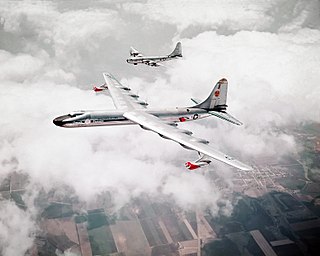
A nuclear-powered aircraft is a concept for an aircraft intended to be powered by nuclear energy. The intention was to produce a jet engine that would heat compressed air with heat from fission, instead of heat from burning fuel. During the Cold War, the United States and Soviet Union researched nuclear-powered bomber aircraft, the greater endurance of which could enhance nuclear deterrence, but neither country created any such operational aircraft.

An SSN is a nuclear-powered general-purpose attack submarine. SSN is the US Navy hull classification symbol for such vessels; the SS denotes a submarine and the N denotes nuclear power. The designation SSN is used for interoperability throughout NATO under STANAG 1166, though navies use other terms.
Soviet naval reactors have been used to power both military and civilian vessels, including:

Obninsk Nuclear Power Plant was built in the "Science City" of Obninsk, Kaluga Oblast, about 110 km (68 mi) southwest of Moscow, Soviet Union. Connected to the power grid in June 1954, Obninsk was the first grid-connected nuclear power plant in the world, i.e. the first nuclear reactor that produced electricity industrially, albeit at small scale. It was located at the Institute of Physics and Power Engineering. The plant is also known as APS-1 Obninsk. It remained in operation between 1954 and 2002, although its production of electricity for the grid ceased in 1959; thereafter it functioned as a research and isotope production plant only.
The following outline is provided as an overview of and topical guide to nuclear technology:
The following outline is provided as an overview of and topical guide to nuclear power: